Daily News
by Gail Helmer
[ Send Us News | Archives ]
COMBATSIM.COM is proud to announce that all one-year members of COMBATSIM.COM qualify for a 10% discount on all Fighter Combat International Flight of Your Life Rides and Air Combat Missions. In return, COMBATSIM.COM has offered all of Fighter Combat International's patrons one month free access to COMBATSIM.COM's member-only area. This is a fantastic value for COMBATSIM.COM readers! Depending on which experience you try, you could save as much as $90.
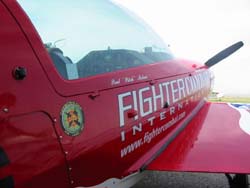
Fighter Combat International, along with its international partner Air Combat Canada, offers exciting aerial combat adventures for individuals, groups, events, and businesses throughout North America. Since 1997, they have enjoyed giving people the opportunity to experience first-hand what it’s like to be a ‘fighter pilot’...because as their client, you have the opportunity to actually fly the plane!
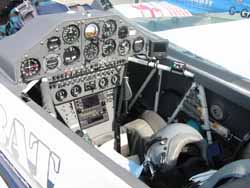
FCI's German-built “Extra 300L” is a world-class unlimited aerobatic aircraft. For the ultimate in realism, the Extras with their in-line seating configuration (not side-by-side) are specially equipped with an integrated laser weapons system, projected gun-sight, smoke generators, and a combat sound card to provide a true-to-life effect!
Office headquarters are located in Mesa, Arizona, near Phoenix, at Williams Gateway Airport. They have an additional branch office in Niagara Canada and deploy to locations across North America. Call 1-888-FLY-HARD in the US, 1-866-FLY-HARD in Canada, or visit the Fighter Combat International website for full details.
The upcoming version of Aces High, the massively multiplayer WWII air, land, and sea sim, will be getting a more sophisticated ground-based supply system. Truck convoys will travel on roads, barges will ply the waters of new rivers, and trains will steam along railroad tracks. These transportation arteries will connect each airfield to an associated town. Click here for an early view of the trains.
NVIDIA Implements OpenGL 1.3 API
NVIDIA Corporation announced today that it has fully implemented the new OpenGL(R) 1.3 Application Programming Interface (API), exposing new features and assisting developers in creating real-time cinematic effects. With its full support of the OpenGL 1.3 API, NVIDIA has enabled new features including multi-texturing, cube mapping, and multi-sample anti-aliasing on NVIDIA's graphics processing units (GPUs), which are used in a variety of computing platforms.
"OpenGL 1.3 represents the latest enhancement to the industry's leading cross-platform 2D and 3D graphics API, exposing all of the features needed to deliver a real-time cinematic experience," stated Dan Vivoli, vice president of marketing for NVIDIA. "Developers equipped with the latest NVIDIA GPU and OpenGL 1.3 API are empowered to create software applications that take graphics quality and realism to new levels."
ATI Unveils Next Generation Graphics Processors
ATI Technologies announced today its next generation RADEON processors, including the RADEON 8500 and the RADEON 7500. Major technological advancements for the RADEON 8500 include TRUFORM II, a rendering technology said to help to deliver smooth, natural 3D images, and SMARTSHADER II, technology that takes advantage of Microsoft’s DirectX 8.1 to enable more complex and realistic texture and lighting effects, including supporting Pixel Shaders Version 1.4. RADEON 7500 is said to deliver up to a 60 percent improvement in performance compared to the previous generation of RADEON processors, and targets the performance mainstream. Available in late September, it has a price of $199.
Northrop Grumman Corporation's Electro-Optical Systems business unit, formerly Litton's Electro-Optical Systems Division, has received a new indefinite delivery/indefinite quantity contract from the U.S. Navy's Naval Surface Warfare Center-Crane Division to produce 7,000 Miniature Night Vision Sights (MNS) for the U.S. Marine Corps (USMC).
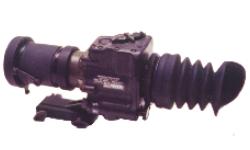
"This contract introduces Northrop Grumman's advanced MNS image-intensified night vision weapon sight to the USMC for the first time," said John Donehoo, president of Northrop Grumman's Electro-Optical Systems business unit. "MNS will improve USMC warfighting capability and significantly reduce the weight load Marines must carry using the currently fielded night vision weapon sights. Northrop Grumman is very proud of the wide acclaim this new night vision system has garnered among U.S. military communities."
The MNS was originally selected as the dedicated miniature night vision sight (AN/PVS-17) for the U.S. Special Operations Command's (USSOCOM) SOPMOD M4A1 carbine program. Lighter and more compact than currently fielded units, the MNS has now been matched with USMC requirements for fielding on the Marines' new M4 Carbine program and will also be used on the M16A2 and M16A4 rifles as well as the M240 and M249 squad automatic weapons. The Marine Corps' MNS will also have a submersible capability of up to 66 feet (20 meters) as is standard with several night vision systems supplied by Northrop Grumman to USSOCOM.
The MNS combines an internally projected, boresighted red dot aim point and a unique dual momentary ON/OFF control that saves battery power. It utilizes the latest image-intensifier tube technology pioneered by Northrop Grumman, including an auto-gated power supply that provides Marines with extended dawn and dusk operation in addition to exceptional low-light night performance. Northrop Grumman is a manufacturer of the latest generations of night vision image intensifiers and systems for military, law enforcement, and search and rescue operations serving all U.S. military services and many allied countries. In addition, the company designs and manufactures advanced infrared sensors/cameras, thin film coatings and laser protection filters.
Lockheed Martin Pitches Russian Airspace Modernisation
Lockheed Martin Air Traffic Management (LMATM) has opened a representative office in Moscow to compete for a broad spectrum of civil aviation infrastructure needs in Russia and other CIS states.
Speaking at a press conference in Moscow, LMATM President Don Antonucci said, "We look forward to establishing technology partnerships with Russia and neighbouring countries to improve the CIS region's aviation infrastructure. These improvements can open airspace, generate revenues via overflight and landing fees and thus contribute to economic development and progress in the region."
As an initial step, the company also proposed the deployment of new technology to provide air traffic control for major segments of Russian airspace currently uncontrolled by radar.
Lockheed Martin is proposing that its advanced system for non-radar controlled airspace management be deployed at two to four centres in northern Russia. These installations would provide control for the first time in areas currently unserved by radar and modernise cross-polar air traffic management for flights from North America, saving time and fuel costs for airlines and increasing overflight revenues for Russia.
"The system we are proposing to deploy is similar to one recently selected by the US Federal Aviation Administration for installation at the three FAA centres that control over half of the world's oceanic airspace," said Antonucci. "It relies on advanced satellite position reporting and data communications to improve situational awareness. The system also includes a conflict probe that allows aircraft to fly closer together and select optimal routes, which improves efficiencies in using the airspace. It is ideally suited for handling significant traffic loads in non-radar controlled airspace, such as northern Russia and the polar region."
The company is also working with transportation authorities in Russia and surrounding states to plan other airspace modernisation projects. In December 2000, LMATM signed 15-year agreement to modernise the Republic of Georgia's aviation infrastructure. Under the agreement, the company is evaluating a wide range of aviation related projects, such as the establishment of a regional airline. The company has held detailed discussions on transportation and other infrastructure initiatives in Kazakhstan and hopes to conclude an agreement within the next few months. Similarly, last month, the company signed a memorandum of agreement with the Ukraine to plan an aviation modernisation program.
Smiths Aerospace To Supply HUMS For UK Sea Kings
The UK Ministry of Defence has awarded Smiths Aerospace a £40 million contract to design and install their Generic Health and Usage Monitoring System (GenHUMS) to the fleet of Sea King helicopters flown by the Royal Navy. The MoD currently operates 90 Sea Kings of various models. The systems will be delivered beginning in 2004 with completion in early 2007.
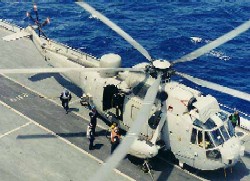
The GenHUMS system is an integrated cockpit voice and flight data recorder with a health and usage monitoring system, installed on each aircraft as a 'single box' system. It continuously checks the performance of safety-critical components, providing advance warning of potential equipment failures and collecting valuable data for routine maintenance of the helicopters. It provides sensors that monitor the status and usage of the engines, transmission, drivetrain system, rotor system and airframe by detecting and diagnosing potential failures, monitoring usage, automating test procedures and providing alerts for potential maintenance actions.
Smiths Aerospace is the prime contractor to the MoD for all contract activities. This includes tailoring the system to various models of the Sea King, aircraft trial installations, system verification, and airworthiness approvals.
Bob Ehr, president of Smiths Aerospace, Electronic Systems business said: "Our HUMS solution represents the latest technology, developed and proven in over one million flight hours of real world operations. The integrated system offers both improved safety and reduced operating costs for a variety of helicopter platforms."
The Smiths Aerospace GenHUMS equipment entered operational service on the UK Ministry of Defence Chinooks in September 2000 at RAF Odiham. The Sea King GenHUMS is common with the system already fitted to the UK MoD Chinook Mk2/2a fleet and with the systems proposed for the UK Puma, Lynx and Chinook Mk3 fleets. Derivatives of the GenHUMS have been selected for the BA-609 helicopter and are currently flying on Bell 412 and Sikorsky CH-53. In addition, Bell Helicopter is offering the Smiths' HUMS for all international AH-1Z King Cobra sales.
NASA’S Helios Solar Airplane High Flying
The solar-powered plane soared to as high as 96,500 feet during a marathon flight that squeezed as much sunlight as possible from the long summer Hawaiian day. The NASA craft, known as Helios, easily overtook the 80,200-foot record for propeller-powered aircraft and the 85,068-foot mark for all non-rocket planes.
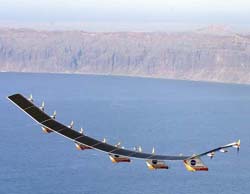
But the high point was just short of the 100,000-foot goal that NASA project managers had set for the remote-controlled craft. The plane took off at 8:48 a.m. local time Monday and landed at 1:43 a.m. Tuesday, according to AeroVironment, the California builder of the craft.
The plane boasts a wingspan longer than a Boeing 747, weighs less than many automobiles and uses solar-powered motors to power 14 propellers. During the record-breaking flight, it flew at speeds ranging from 20 mph to 170 mph.
Thinning air and waning sunlight slowed and eventually stopped the plane's climb as it approached 100,000 feet, convincing NASA managers to bring it home to the island of Kauai.
[ Send Us News | Archives ]
by Gail Helmer
Tuesday August 14, 2001
- Fly Hard! COMBATSIM and FCI
- Aces High Trains Revealed
- NVIDIA Implements OpenGL 1.3 API
- ATI Unveils Next Generation Graphics Processors
- Miniature Night Vision Sights For USMC
- Lockheed Martin Pitches Russian Airspace Modernisation
- Smiths Aerospace To Supply HUMS For UK Sea Kings
- NASA’S Helios Solar Airplane High Flying
COMBATSIM.COM is proud to announce that all one-year members of COMBATSIM.COM qualify for a 10% discount on all Fighter Combat International Flight of Your Life Rides and Air Combat Missions. In return, COMBATSIM.COM has offered all of Fighter Combat International's patrons one month free access to COMBATSIM.COM's member-only area. This is a fantastic value for COMBATSIM.COM readers! Depending on which experience you try, you could save as much as $90.

Fighter Combat International, along with its international partner Air Combat Canada, offers exciting aerial combat adventures for individuals, groups, events, and businesses throughout North America. Since 1997, they have enjoyed giving people the opportunity to experience first-hand what it’s like to be a ‘fighter pilot’...because as their client, you have the opportunity to actually fly the plane!

FCI's German-built “Extra 300L” is a world-class unlimited aerobatic aircraft. For the ultimate in realism, the Extras with their in-line seating configuration (not side-by-side) are specially equipped with an integrated laser weapons system, projected gun-sight, smoke generators, and a combat sound card to provide a true-to-life effect!
Office headquarters are located in Mesa, Arizona, near Phoenix, at Williams Gateway Airport. They have an additional branch office in Niagara Canada and deploy to locations across North America. Call 1-888-FLY-HARD in the US, 1-866-FLY-HARD in Canada, or visit the Fighter Combat International website for full details.
PC News
Aces High Trains RevealedThe upcoming version of Aces High, the massively multiplayer WWII air, land, and sea sim, will be getting a more sophisticated ground-based supply system. Truck convoys will travel on roads, barges will ply the waters of new rivers, and trains will steam along railroad tracks. These transportation arteries will connect each airfield to an associated town. Click here for an early view of the trains.
NVIDIA Implements OpenGL 1.3 API
NVIDIA Corporation announced today that it has fully implemented the new OpenGL(R) 1.3 Application Programming Interface (API), exposing new features and assisting developers in creating real-time cinematic effects. With its full support of the OpenGL 1.3 API, NVIDIA has enabled new features including multi-texturing, cube mapping, and multi-sample anti-aliasing on NVIDIA's graphics processing units (GPUs), which are used in a variety of computing platforms.
"OpenGL 1.3 represents the latest enhancement to the industry's leading cross-platform 2D and 3D graphics API, exposing all of the features needed to deliver a real-time cinematic experience," stated Dan Vivoli, vice president of marketing for NVIDIA. "Developers equipped with the latest NVIDIA GPU and OpenGL 1.3 API are empowered to create software applications that take graphics quality and realism to new levels."
ATI Unveils Next Generation Graphics Processors
ATI Technologies announced today its next generation RADEON processors, including the RADEON 8500 and the RADEON 7500. Major technological advancements for the RADEON 8500 include TRUFORM II, a rendering technology said to help to deliver smooth, natural 3D images, and SMARTSHADER II, technology that takes advantage of Microsoft’s DirectX 8.1 to enable more complex and realistic texture and lighting effects, including supporting Pixel Shaders Version 1.4. RADEON 7500 is said to deliver up to a 60 percent improvement in performance compared to the previous generation of RADEON processors, and targets the performance mainstream. Available in late September, it has a price of $199.
Military News
Miniature Night Vision Sights For USMCNorthrop Grumman Corporation's Electro-Optical Systems business unit, formerly Litton's Electro-Optical Systems Division, has received a new indefinite delivery/indefinite quantity contract from the U.S. Navy's Naval Surface Warfare Center-Crane Division to produce 7,000 Miniature Night Vision Sights (MNS) for the U.S. Marine Corps (USMC).

"This contract introduces Northrop Grumman's advanced MNS image-intensified night vision weapon sight to the USMC for the first time," said John Donehoo, president of Northrop Grumman's Electro-Optical Systems business unit. "MNS will improve USMC warfighting capability and significantly reduce the weight load Marines must carry using the currently fielded night vision weapon sights. Northrop Grumman is very proud of the wide acclaim this new night vision system has garnered among U.S. military communities."
The MNS was originally selected as the dedicated miniature night vision sight (AN/PVS-17) for the U.S. Special Operations Command's (USSOCOM) SOPMOD M4A1 carbine program. Lighter and more compact than currently fielded units, the MNS has now been matched with USMC requirements for fielding on the Marines' new M4 Carbine program and will also be used on the M16A2 and M16A4 rifles as well as the M240 and M249 squad automatic weapons. The Marine Corps' MNS will also have a submersible capability of up to 66 feet (20 meters) as is standard with several night vision systems supplied by Northrop Grumman to USSOCOM.
The MNS combines an internally projected, boresighted red dot aim point and a unique dual momentary ON/OFF control that saves battery power. It utilizes the latest image-intensifier tube technology pioneered by Northrop Grumman, including an auto-gated power supply that provides Marines with extended dawn and dusk operation in addition to exceptional low-light night performance. Northrop Grumman is a manufacturer of the latest generations of night vision image intensifiers and systems for military, law enforcement, and search and rescue operations serving all U.S. military services and many allied countries. In addition, the company designs and manufactures advanced infrared sensors/cameras, thin film coatings and laser protection filters.
Lockheed Martin Pitches Russian Airspace Modernisation
Lockheed Martin Air Traffic Management (LMATM) has opened a representative office in Moscow to compete for a broad spectrum of civil aviation infrastructure needs in Russia and other CIS states.
Speaking at a press conference in Moscow, LMATM President Don Antonucci said, "We look forward to establishing technology partnerships with Russia and neighbouring countries to improve the CIS region's aviation infrastructure. These improvements can open airspace, generate revenues via overflight and landing fees and thus contribute to economic development and progress in the region."
As an initial step, the company also proposed the deployment of new technology to provide air traffic control for major segments of Russian airspace currently uncontrolled by radar.
Lockheed Martin is proposing that its advanced system for non-radar controlled airspace management be deployed at two to four centres in northern Russia. These installations would provide control for the first time in areas currently unserved by radar and modernise cross-polar air traffic management for flights from North America, saving time and fuel costs for airlines and increasing overflight revenues for Russia.
"The system we are proposing to deploy is similar to one recently selected by the US Federal Aviation Administration for installation at the three FAA centres that control over half of the world's oceanic airspace," said Antonucci. "It relies on advanced satellite position reporting and data communications to improve situational awareness. The system also includes a conflict probe that allows aircraft to fly closer together and select optimal routes, which improves efficiencies in using the airspace. It is ideally suited for handling significant traffic loads in non-radar controlled airspace, such as northern Russia and the polar region."
The company is also working with transportation authorities in Russia and surrounding states to plan other airspace modernisation projects. In December 2000, LMATM signed 15-year agreement to modernise the Republic of Georgia's aviation infrastructure. Under the agreement, the company is evaluating a wide range of aviation related projects, such as the establishment of a regional airline. The company has held detailed discussions on transportation and other infrastructure initiatives in Kazakhstan and hopes to conclude an agreement within the next few months. Similarly, last month, the company signed a memorandum of agreement with the Ukraine to plan an aviation modernisation program.
Smiths Aerospace To Supply HUMS For UK Sea Kings
The UK Ministry of Defence has awarded Smiths Aerospace a £40 million contract to design and install their Generic Health and Usage Monitoring System (GenHUMS) to the fleet of Sea King helicopters flown by the Royal Navy. The MoD currently operates 90 Sea Kings of various models. The systems will be delivered beginning in 2004 with completion in early 2007.

The GenHUMS system is an integrated cockpit voice and flight data recorder with a health and usage monitoring system, installed on each aircraft as a 'single box' system. It continuously checks the performance of safety-critical components, providing advance warning of potential equipment failures and collecting valuable data for routine maintenance of the helicopters. It provides sensors that monitor the status and usage of the engines, transmission, drivetrain system, rotor system and airframe by detecting and diagnosing potential failures, monitoring usage, automating test procedures and providing alerts for potential maintenance actions.
Smiths Aerospace is the prime contractor to the MoD for all contract activities. This includes tailoring the system to various models of the Sea King, aircraft trial installations, system verification, and airworthiness approvals.
Bob Ehr, president of Smiths Aerospace, Electronic Systems business said: "Our HUMS solution represents the latest technology, developed and proven in over one million flight hours of real world operations. The integrated system offers both improved safety and reduced operating costs for a variety of helicopter platforms."
The Smiths Aerospace GenHUMS equipment entered operational service on the UK Ministry of Defence Chinooks in September 2000 at RAF Odiham. The Sea King GenHUMS is common with the system already fitted to the UK MoD Chinook Mk2/2a fleet and with the systems proposed for the UK Puma, Lynx and Chinook Mk3 fleets. Derivatives of the GenHUMS have been selected for the BA-609 helicopter and are currently flying on Bell 412 and Sikorsky CH-53. In addition, Bell Helicopter is offering the Smiths' HUMS for all international AH-1Z King Cobra sales.
NASA’S Helios Solar Airplane High Flying
The solar-powered plane soared to as high as 96,500 feet during a marathon flight that squeezed as much sunlight as possible from the long summer Hawaiian day. The NASA craft, known as Helios, easily overtook the 80,200-foot record for propeller-powered aircraft and the 85,068-foot mark for all non-rocket planes.

But the high point was just short of the 100,000-foot goal that NASA project managers had set for the remote-controlled craft. The plane took off at 8:48 a.m. local time Monday and landed at 1:43 a.m. Tuesday, according to AeroVironment, the California builder of the craft.
The plane boasts a wingspan longer than a Boeing 747, weighs less than many automobiles and uses solar-powered motors to power 14 propellers. During the record-breaking flight, it flew at speeds ranging from 20 mph to 170 mph.
Thinning air and waning sunlight slowed and eventually stopped the plane's climb as it approached 100,000 feet, convincing NASA managers to bring it home to the island of Kauai.
